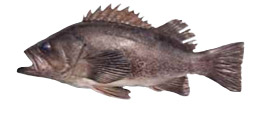
BLACK ROCKFISH
Body black or grey in color. Also called seabass and black bass. Large mouth, rounded anal fin.

Body black or grey in color. Also called seabass and black bass. Large mouth, rounded anal fin.
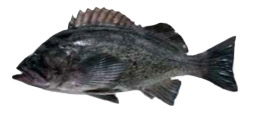
Body is blue or black. Forehead has several diagonal bars. Has a small mouth. The anal fin is vertical or slanted posteriorly.
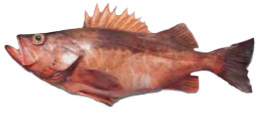
Lower jaw greatly projecting and elongated body. Body orange, olive, or brown. Large mouth extending past rear of eye, and projecting lower jaw.

Body olive green to grey with lighter mottling. Two fins on back. Skin flap between nostrils. Small teeth.

3 orange stripes across head; lateral line in clear gray zone and orange mottling. Bright orange or yellow body, mottled with grey. Fins are orange without black edge. Three orange stripes across the head. Chin smooth to the touch. Anal fin sharp and angular.

Body blue or black spotted with yellow and white. Prominent yellow stripe extending from top of back to along lateral line to caudal fin.
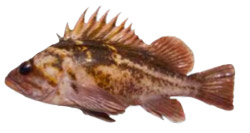
Body variable in color with light colored stripe along the rear of the lateral line. Two dark bars radiating from eye.

Size: up to 6'. Color: white on one side; brown-gray on the other. Look for: large mouth and eyes on right side of body. Three points on tail.
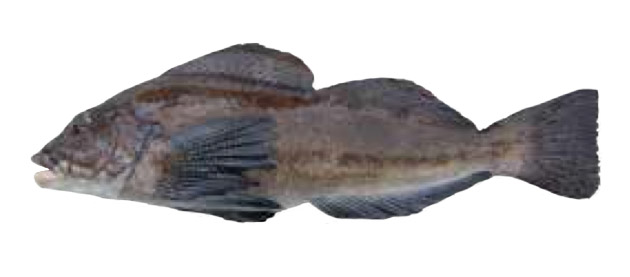
Size: up to 21". Color: gray to brownish-olive, with irregular blue spots on the front half of their bodies. Look for: eyelike spot at the end of the soft dorsal fin, just in front of the tail.
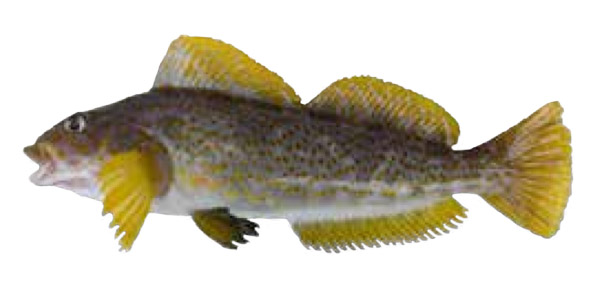
Size: up to 21". Color: small, reddish-brown to golden spots on a gray to brown body. Look for: yellowish orange fins.
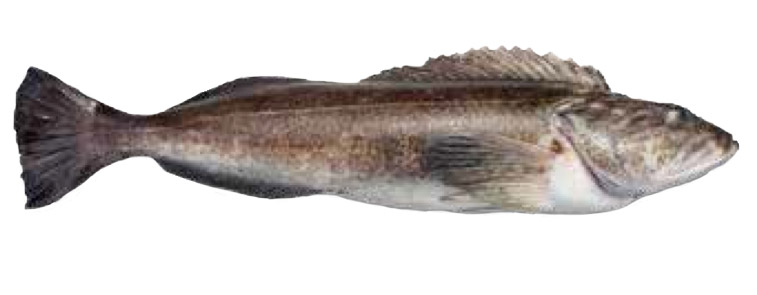
Body dark brown, grey or green with mottling on sides. A single long fin on back with only one notch. Large mouth with large teeth. Can reach five feet in length.
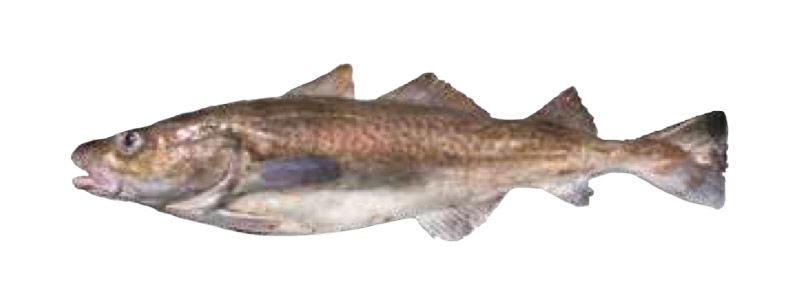
Brown to grey body with lighter mottling. Three fins on back and a large "whisker" under lower jaw. Also called true cod and grey cod.
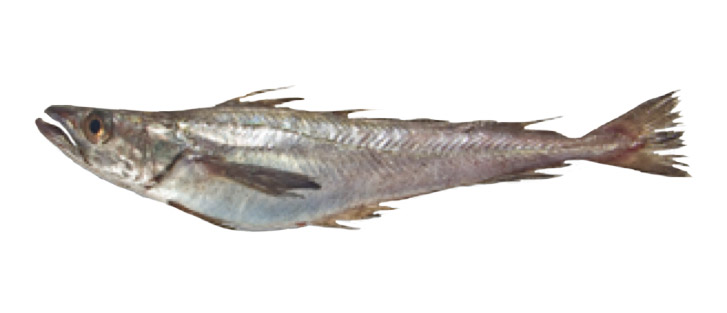
Body dark or silver grey becoming silvery below. Two fins on back, the second being deeply notched. Black inside mouth. Large mouth with sharp teeth. Also called whiting.
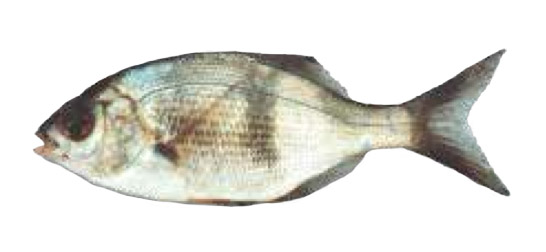
Size: up to 17". Color: dusky to silvery gray, with dark bar in middle of body. Look for: deeply forked tail and dark spot on gill cover.
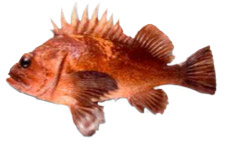
Body brown with yellow mottling. High fin on back with yellow mottling. May have freckles on head and throat. Tow light saddle patches on top of back.

Size: up to 23". Color: white on one side top of body brown to green, small mouth. Look for: right-eyed fish, laterna line arches above the pectoral fin.
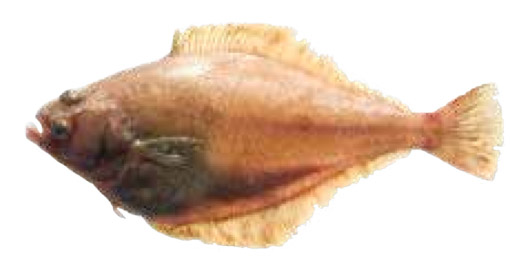
Size: up to 16". Color: one side is off-white other side is brown with mottling. Look for: left-eyed fish, squared caudal fin.
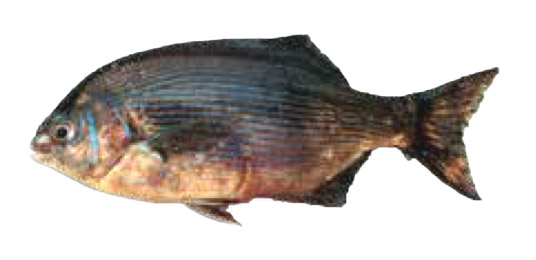
Size: up to 15". Color: blue and yellow stripes on side of body. Look for: bright color pattern.

Body pink to red with five red to black vertical stripes. Strong ridges between eyes. Two dark bars radiating from eye.
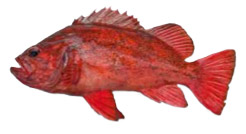
Reddish and mottled with gray. Body dark red and mottled gray. Red mouth and underside of jaw is rough. Fins may be edged with black. Anal fin rounded.
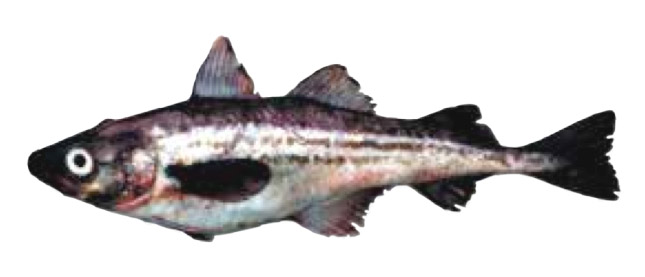
Body brown with mottling, usually with several stripes along the body. Three fins on back. The "whisker" under lower jaw is absent or very small. Large eye with small pupil.
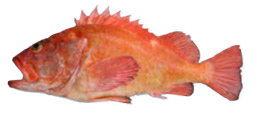
Brilliant yellow eye and raspy ridges above eye; fins usually have black edges. Orange-red to yellow body color, bright yellow eye, and fins may be tinged with black. Raspy ridges above eye, rear of anal fin vertical. Also called rasphead rockfish and red snapper. Typically the larges species of rockfish.
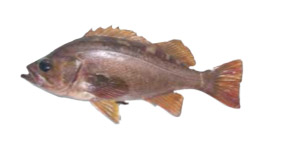
Olive green body with yellow-green fins. May have knob at tip of lower jaw. Rear edge of anal fin vertical.


Atlantic salmon have large black spots on the gill covers and back, and rarely any spots on the tail fin. Their scales are large, there is no red stripe along the lateral line, and they ahve 8-10 anal fin rays. Atlantic salmon may be taken from marine waters during any open salmon season, and from anadromous (no landlocked) freshwater during any open salmon or trout season. Anglers may not, however, continue to fish for Atlantic salmon after a daily limit of another species of salmon has been retained. In landlocked lakes, Atlantic salmon may be taken as part of the trout daily limit. Seasons and size limits in place for trout apply to Atlantic salmon in landlocked lakes. Opportunities to harvest Atlantic salmon beyond those listed in the pamphlet will be announced to the news media and carried on WDFW's recreational fishing hotline. Please report sightings to (360) 902-2700.

Jaw: mouth is white and the gum link is almost white, but the tongue may be black. The teeth are shark and strong. Tail: has just a few scatered spots, usually on the upper lobe, with silver streaks. It has a wide caudal peduncle. Black spots on back with a few spots on the upper portion of the tail. White mouth with a white gum line and dark tongue. Average size scales. Silver pigment on the tail.
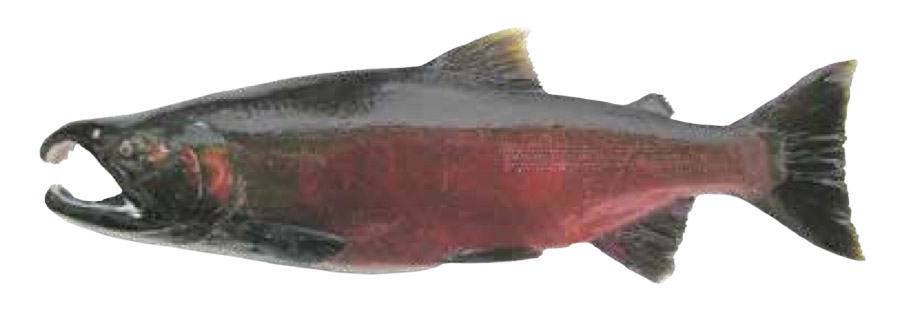
Mature Coho salmon display a greenish-black head with a red to maroon colored body. Spots are foun on the back and only upper lobe of the tail. The mouth is black with a white gum line. Typically male Coho display brighter coloration and have a more pronounced elongated hooked snout.

Jaw: has a dark mouth and black gums at the base of its teeth. Immature chinook are known as "blackmouth." Tail: both the upper and lower lobes of the tail are covered with spots and silver is prominent. Large black spots on back, dorsal fin, and both the upper and lower lobes of the tail. Black mouth with a black gum line. Average size scales. Silver pigment on the tail. Prominent teeth.

Chinook salmon do not display the conspicuous morphological changes of Pink, Chum and Sockeye salmon during the spawning stage. Typically Chinook turn from silvery bright ocean coloration to a darker bronze color. Large spots are found on the back and both lobes of the tail. Mouth is black with a black to grey gum line.

No prominent spots on back or tail (small speckles may be present). White mouth with a white gum line and dark tongue. Large scales. Caudal peduncle (tail base) is slender. Silver pigment on tail.
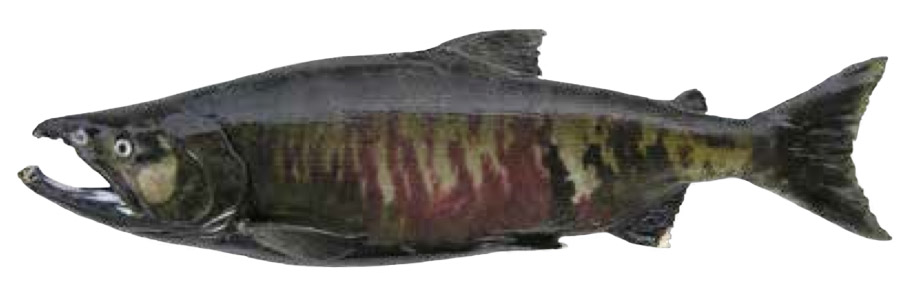
Chum salmon display characteristic olive-green vertical markings on the side of hthete body as they approach spawning. There are no spots on the back or tail. Male Chum salmon develop a more elongated snout with large canine-like teeth and also have reddish-purple vertical markings in addition to the olive-green markings.

Jaw: mouth of a pink is white, but the gums and tongue are black, as they are in a Chinook. It does not have "teeth" on its tongue. Tail: is covered with large oval spots. It does not have silver on the tail. The scales are very small compared to other salmon of the same size. Generally large black spots on back and heavy oval shaped black blotches on the upper and lower lobes of the tail. White mouth with a black gum line and tongue. Very small scales. No silver pigment on the tail. Flexible (rubbery) lower jaw.

The majority of pink salmon return on odd-numbered years. Pink salmon have large oblong spots on the back and both lobes of the tail. Pink salmon, like most other salmon transform from silvery bright ocean coloration to a more dull and darker color. Makes develop a pronounced hump as they approach spawning.
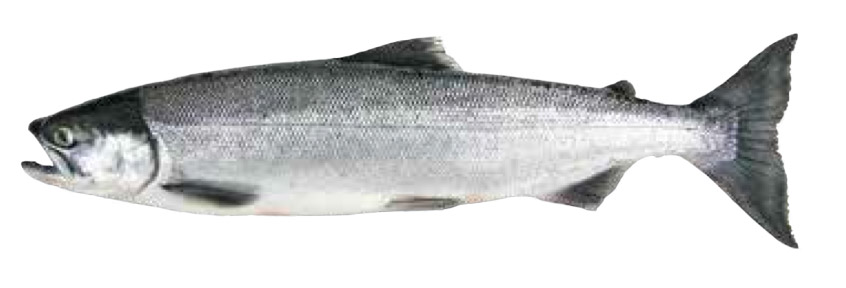
No prominent spots on back or tail (small speckles may be present). White mouth with a white gum line and dark tongue. Average size scales. Prominent gold-colored eyes. No silver pigment in the tail. Small teeth.
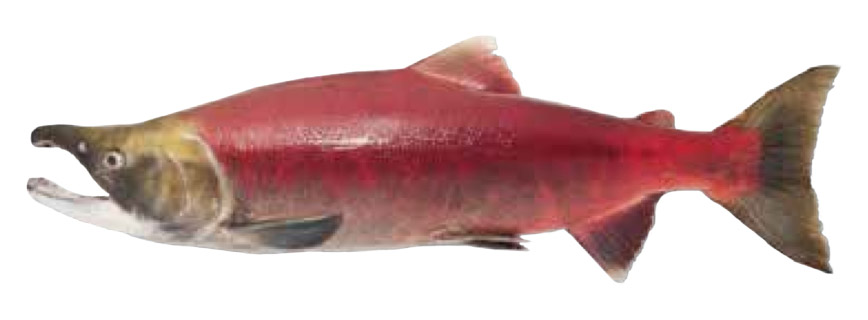
Sockeye turn brick red to scarlet red along their body with a greenish head. Female coloration is often more dull colored. There are no distinct spots on the back or tail. Sockeye can be found spawning in both lakes, streams, and rivers, while other Pacific salmon spawn in streams and rivers.

Venerupis philippinaarum
Average size is 1-2", up to 2 1/2". Oblong shell has concentric and radiating lines. Siphon tips are split. Found to 4" below surface.

Leukoma staminea
Average size is 1-2", up to 2 1/2". Rounded shell has concentric and radiating lines. Siphon tips are fused. Found to 6-10" below surface.
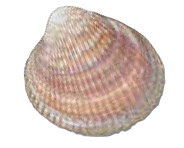
Clinocardium nuttallii
Prominent, evenly-spaced ridges which fan out from the hinge. Mottled, light brown. Can grow to 5". Found just below surface.

Saxidomus giganteus
Average size is 3-4", up to 6". Shells have no radiating ridges and are usually chalky- white. The siphon can be pulled into its shell. Usually found 12-18" below surface.
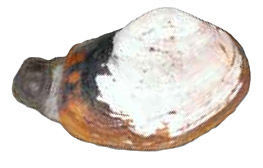
Tresus capax (shown)
Tresus nuttallii (not shown)
Large, can grow up to 8". Shell is chalky-white with yellow-brown patches of "skin". The siphon can't be pulled into shell and has a leather-like flap on the tip. Found 1-2 feet below surface.
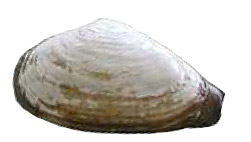
Mya arenaria
Can grow to 6". Shells are soft, chalky-white with a rough irregular surface. Shell is rounded at the foot end, pointed at the siphon end. Siphon doesn't have leather-like flap on the tip. Found to 18" below the surface.
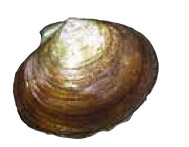
Nuttallia obscurata
Up to 3", with shiny brown coating on the outside, purple on the inside of shell.
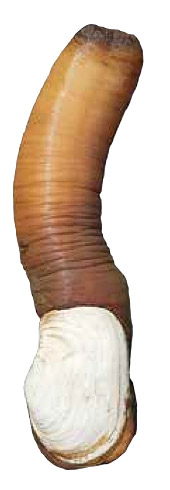
Panopea generosa
Heavy, oblong shell, rounded at one end. Appears cut-off at the
other. The siphon can't be pulled into the shell. Found 2-3 feet below surface. Can weigh up to 10 lbs.
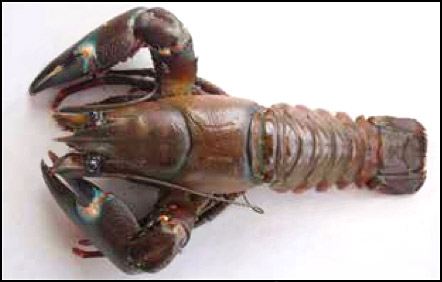
Pacifastacus leniusculus
Claws can range in color from blue or green with red underneath. White or light colored claw joints. No pronounced bumps or distinct dark tips on claws.

Not pictured: Nonnative Red Swamp Crayfish and Nonnative Northern Crayfish. Nonnative species have pronounced bumps on claws.
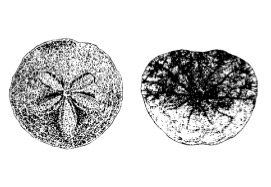
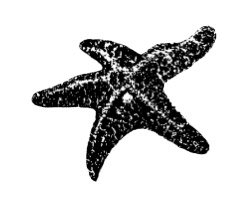

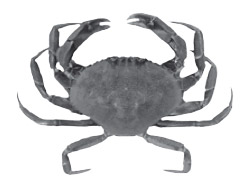



The shell is about 1 1/2" with ornate ridges commonly attached to clam and oyster shells. Egg cases are yellow to reddish. A voracious predator of marine bivalves. It is unlawful to transfer Japanese oyster drills from one beach to another. (WAC 220-72-011 and WAC 220-72-015)
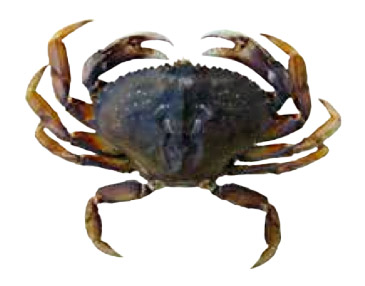
White-tipped claws, brownish shell.
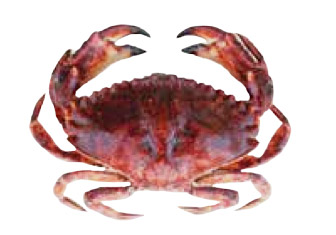
Black-tipped claws, reddish shell, shell much wider than long.
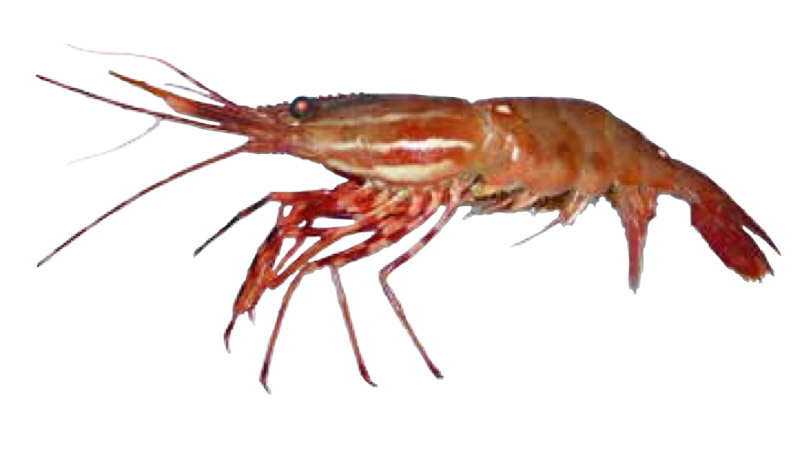
Pandalus platyceros
Distinguished by four white spots on the body. Spot shrimp may reach 10" in total length.

Pandalus eous and P. jordani
Small (less than 6") and uniformly pink.

Pandalus hypsinotus
Mottled reddish-brown with some white patches on the head and tail. This species may reach 7 1/2" in length.

Pandalus danae
Brownish in color with brown lines and spots on the head and tail. This species may grow to 5 1⁄2" in length.

Size: up to 15'
Color: dark brown or gray
Look for: one fin on back situated towards tail. Six gill slits on each side of head.

Dark brown upper body with white belly, white spots sometimes on upper body. Single prominent spines in front of each dorsal fin. Lacks an anal fin.

Size: up to 10". Color: silver with dark blue-green back. Look for: deeply forked tail and lack of adipose fin.

Size: up to 12". Color: bluish on upper half with silvery white sides and belly. Look for: grooves on gill cover, skinny head, speckled tail.

Size: up to 10". Color: silver with a stripe along the side. Look for: small adipose fin and stripe on the side.
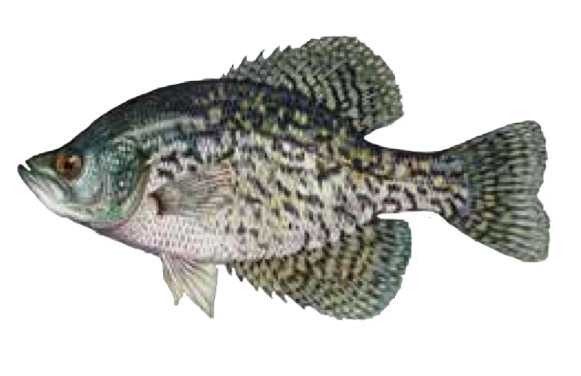
The body is silvery with dark spots. The fins have dark bands. White crappie may have vertical bars on the sides.
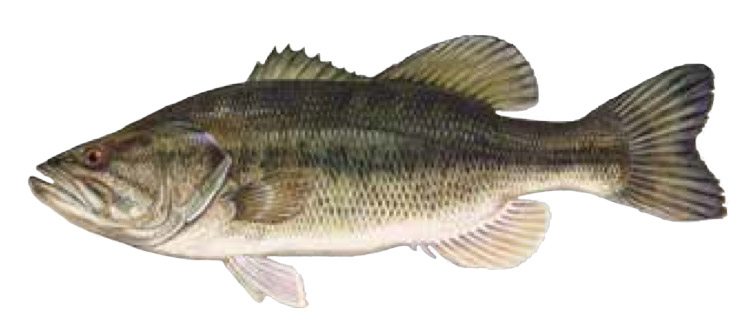
This bass is dark green on the back and sides, with a dark, horizontal band along its sides. The belly is white. The large jaw, when closed, extends behind the eye.
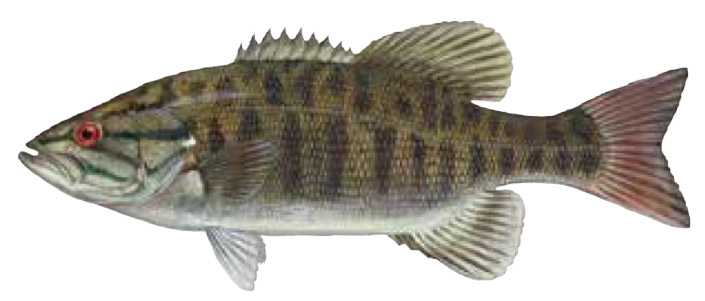
This bass is dark olive to brown on the back with a white belly. The sides are bronze and have dark vertical bands. The small jaw does not extend behind the eyes.

Body color is variable. Numerous closely grouped spots on dorsal fin and tail. The maxillary (upper jaw bone) usually extends beyond the back of the eye. may have red or orange slash on the underside of jaw.

Dark green or blue with white belly; its upper body and dorsal fin have wormlike markings. Its sides have yellow and pink spots with blue rings. The lower fins are white-tipped and the tail is square.

Body color is variable and may be silvery in lakes and reservoirs. Numerous closely grouped spots on dorsal fin and tail. The maxillary (upper jaw bone) does not usually extend beyond the back of the eye.

This trout's back is brown or olive with large spots. Sides are light brown to yellowish with large dark spots surrounded by halos of blue-gray. The tail has few spots.